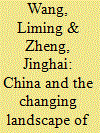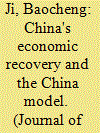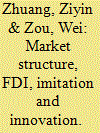|
|
|
Sort Order |
|
|
|
Items / Page
|
|
|
|
|
|
|
| Srl | Item |
| 1 |
ID:
100255


|
|
|
|
|
| Publication |
2010.
|
| Summary/Abstract |
The rapid development of emerging markets is changing the landscape of the world economy and may have profound implications for international relations. China is often regarded as the most influential emerging market economy because, during the last three decades, it has become increasingly integrated into the world economic system and its success and failure now affect the well-being of other nations in the world. As the financial crisis in the US and EU intensifies, the economic prosperity of the world depends to a large extent on the sustained development of the Chinese economy and other emerging markets, and vice versa.
|
|
|
|
|
|
|
|
|
|
|
|
|
|
|
|
| 2 |
ID:
100256


|
|
|
|
|
| Publication |
2010.
|
| Summary/Abstract |
Starting with the US subprime crisis, the world has fallen into the most severe economic crisis since the Great Depression. Unlike other major nations, China was the first to recover from the economic downturn. Researchers and policymakers have begun to wonder if China could actually bring the world out of the financial crisis. This paper intends to contribute to the discussion relating China's outstanding economic performance with reference to the 'China model'. China has recently managed to escape from the world economic recession and demonstrated a strong tendency for full recovery. The core reason lies in the fact that the Chinese system is characterized with a unique mechanism of resource allocation, and a macroeconomic decision-making process functions as a powerful and effective instrument with regard to crisis management. Moreover, the existence of state enterprises that are compatible with a market-oriented economy has played an important role in stimulating economic activity.
|
|
|
|
|
|
|
|
|
|
|
|
|
|
|
|
| 3 |
ID:
100260


|
|
|
|
|
| Publication |
2010.
|
| Summary/Abstract |
It is commonly argued that China's financial markets are effectively insulated from the rest of the world. To see if this is true, and to better understand China's financial development, we analyse China's integration with major financial markets. Using conditional copulas, we show that China has experienced an increasing level of integration with several major financial markets during the last decade, albeit at a slow pace and from very low levels. Furthermore, the level of integration has increased with several major markets during the global financial crisis. The results and possible reasons for the increasing integration are analysed and the implications for policymakers and market participants are discussed.
|
|
|
|
|
|
|
|
|
|
|
|
|
|
|
|
| 4 |
ID:
100261


|
|
|
|
|
| Publication |
2010.
|
| Summary/Abstract |
This paper tests the volatility spillovers between the Shanghai market and the main developed stock markets abroad, namely New York, Tokyo, London, and Frankfurt, as well as between the Shanghai market and the emerging stock markets, namely Hong Kong, and Korea. The tests cover the period of 11 July 2005-12 July 2007 and 1 August 2007-10 July 2009, since the financial crisis started from July 2007. To account for asymmetries in the volatility transmission mechanism, we have used the GARCH and EGARCH model. The main findings are as follows. First, the degree of the Leverage Effect of the Shanghai market changes in the opposite direction from most of the other sample markets after the financial crisis began in July 2007. This change implies that investors in the Shanghai markets began to pay close attention to bad news. Secondly, reciprocal spillovers exist for some market pairs before the crisis, as the Shanghai A-share market has unidirectional influence on the emerging markets. After the onset of the financial crisis, the stock markets in developed countries have bidirectional influences on each other. The financial crisis brings the developed markets closer together than before, but they do not receive volatility spillover from the Shanghai A-share market. The financial crisis also influences the Asian emerging markets so as to decrease the volatility transmission that comes from the Shanghai A-share market. The Chinese mainland market is still not a vital security market in the world, although it has become the third largest one. Thirdly, the risk-precautionary role of the Shanghai B-share market is not as significant as expected.
|
|
|
|
|
|
|
|
|
|
|
|
|
|
|
|
| 5 |
ID:
100257


|
|
|
|
|
| Publication |
2010.
|
| Summary/Abstract |
Regional disparities are particularly high in some larger emerging economies, such as Russia and China, and inter-provincial inequality in China has increased rapidly after 1990. In the literature, a statistical link between globalisation and increased regional disparities in China has been established, but not the precise mechanisms and causal relationships. In the paper, we therefore simulate a world trade model with 166 countries and regions in order to shed light on these mechanisms and the future development of regional disparities in China. Our results suggest that the faster growth in coastal regions may be caused by the role of these regions as transport hubs for international trade. However, uneven growth could also be caused by domestic trade disintegration, as suggested by some other research. In the paper, we demonstrate these mechanisms, but we are not able to draw firm conclusions about the relative role each of them play empirically. The weaker development for some peripheral regions can be reversed by stronger domestic trade integration or better cross-border infrastructure.
|
|
|
|
|
|
|
|
|
|
|
|
|
|
|
|
| 6 |
ID:
100258


|
|
|
|
|
| Publication |
2010.
|
| Summary/Abstract |
We develop an extended North-South model to analyse the US-China IPRs conflict and possible policies. In our model, innovation in the North (US), imitation in the South (China), and Foreign Direct Investment (FDI) are all endogenous. We predict that whether tighter IPRs benefit the US or China depends crucially on market structure. In an oligopoly market induced by vertical innovation, tighter IPRs hurt both economies; while, in a monopolistic competition market induced by horizontal innovation, tighter IPRs benefit both economies as long as the degree of IPRs is appropriately chosen. We prove the existence of an optimal degree of IPRs protection in China, which may differentiate it from that in the US.
|
|
|
|
|
|
|
|
|
|
|
|
|
|
|
|
| 7 |
ID:
100259


|
|
|
|
|
| Publication |
2010.
|
| Summary/Abstract |
The paper sets up a small open economy general equilibrium model to study the dynamics of the adjustment of trade imbalances under different policies based on the Chinese economy. The policies that adjust domestic prices require a long period to achieve trade balance and induce fluctuations of output and inflation, regardless of whether capital markets are open or closed, while policies that adjust the exchange rate quickly result in diminished trade surpluses, and do not cause fluctuations of output and inflation. However, policies that adjust the exchange rate slowly also lead to fluctuations under a capital flow setting. Nominal frictions are important factors to these differences, because they slow down the price adjustment, but do not bother the exchange rate changes. From the perspective of welfare, fast exchange rate adjustment policies are better than price policies, and adjustment under capital flow is better than adjustment under capital control. The implications for China's trade surplus are analyzed.
|
|
|
|
|
|
|
|
|
|
|
|
|
|
|
|
|
|
|
|
|